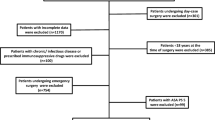Abstract
The prognostic nutritional index is an effective prognostic tool used in gastrointestinal surgeries. However, its value has not been verified in cardiovascular surgeries. This study aimed to investigate its utility in hemodialysis-dependent patients undergoing cardiac surgery. We retrospectively reviewed data of 110 hemodialysis-dependent patients who underwent cardiac surgery between January 2006 and July 2016. 20 variables were evaluated for short- and long-term mortality prediction. Patients were divided into high and low prognostic nutritional index groups with values > 34 (n = 90) and ≤ 34 (n = 20), respectively. Preoperative characteristics and surgical outcomes were compared between both groups. Overall, the in-hospital mortality rate was 9% (n = 10) and the 1-, 3-, and 5-year actual survival rates were 69%, 58%, and 40%, respectively. Univariate analysis for hospital death revealed age ≥ 70 years, body mass index ≤ 18 kg/m2, total cholesterol ≤ 120 mg/dl, concomitant procedures, albumin concentration ≤ 3.0 g/dl, and prognostic nutritional index ≤ 34 as risk factors. Multivariate logistic regression analysis confirmed age ≥ 70 years and concomitant procedures as independent risk factors. Whereas ejection fraction ≤ 30% and prognostic nutritional index ≤ 34 were strong independent predictors of long-term death. Patients in the low prognostic nutritional index group had significantly longer postoperative hospitalization, higher incidence of complications, significantly higher in-hospital mortality rate, and significantly lower actual survival rate. The low prognostic nutritional index affected surgical outcomes in hemodialysis-dependent patients undergoing cardiac surgery. Perioperative nutrition management based on the prognostic nutritional index may improve surgical outcomes.

Similar content being viewed by others
References
Zimmet AD, Almeida A, Goldstein J, Shardey GC, Pick AW, Lowe CE, Jolley DJ, Smith JA. The outcome of cardiac surgery in dialysis-dependent patients. Heart Lung Circ. 2005;14:187–90.
Filsoufi F, Rahmanian PB, Castillo JG, Silvay G, Carpentier A, Adams DH. Predictors and early and late outcomes of dialysis-dependent patients in contemporary cardiac surgery. J Cardiothorac Vasc Anesth. 2008;22:522–9.
Rahmanian PB, Adams DH, Castillo JG, Vassalotti J, Filsoufi F. Early and late outcome of cardiac surgery in dialysis-dependent patients: single-center experience with 245 consecutive patients. J Thorac Cardiovasc Surg. 2008;135:915–22.
Vohra HA, Armstrong LA, Modi A, Barlow CW. Outcomes following cardiac surgery in patients with preoperative renal dialysis. Interact Cardiovasc Thorac Surg. 2014;18:103–11.
Kawahito K, Aizawa K, Oki S, Saito T, Misawa Y. Heart valve surgery in hemodialysis-dependent patients: nutrition status impact on surgical outcome. J Artif Organs. 2016;19:134–40.
Buzby GP, Mullen JL, Matthews DC, Hobbs CL, Rosato EF. Prognostic nutritional index in gastrointestinal surgery. Am J Surg. 1980;139:160–7.
Iwasa M, Ogoshi S, Kitagawa S, Ohmori Y, Iwasa Y, Mizobuchi S, Tamiya T, Isono K. Effect of Preoperative Hyperalimentation for Patients with Esophageal Cancer and Usefulness of the Nutritional Assessment Index. In: Siewert JR, Hölscher AH, eds. Diseases of the Esophagus. Berlin: Springer; 1988. pp. 264–7.
Kalantar-Zadeh K, Kopple JD, Block G, Humphreys MH. A malnutrition-inflammation score is correlated with morbidity and mortality in maintenance hemodialysis patients. Am J Kidney Dis. 2001;38:1251–63.
Onodera T, Goseki N, Kosaki G. Prognostic nutritional index in gastrointestinal surgery of malnourished cancer patients. Nihon Geka Gakkai Zasshi. 1984;85:1001–5.
Okada S, Shimada J, Teramukai S, Kato D, Tsunezuka H, Miyata N, Ishihara S, Furuya T, Nakazono C, Ishikawa N, Inoue M. Risk stratification according to the prognostic nutritional index for predicting postoperative complications after lung cancer surgery. Ann Surg Oncol. 2018; https://doi.org/10.1245/s10434-018-6368-y (Epub ahead of print).
Ke M, Xu T, Li N, Ren Y, Shi A, Lv Y, He H. Prognostic nutritional index predicts short-term outcomes after liver resection for hepatocellular carcinoma within the Milan criteria. Oncotarget. 2016;7:81611–20.
Mohri Y, Inoue Y, Tanaka K, Hiro J, Uchida K, Kusunoki M. Prognostic nutritional index predicts postoperative outcome in colorectal cancer. World J Surg. 2013;37:2688–92.
Yamada K, Furuya R, Takita T, Maruyama Y, Yamaguchi Y, Ohkawa S, Kumagai H. Simplified nutritional screening tools for patients on maintenance hemodialysis. Am J Clin Nutr. 2008;87:106–13.
Lowrie EG, Lew NL. Death risk in hemodialysis patients: the predictive value of commonly measured variables and an evaluation of death rate differences between facilities. Am J Kidney Dis. 1990;15:458–82.
Moshage HJ, Janssen JA, Franssen JH, Hafkenscheid JC, Yap SH. Study of the molecular mechanism of decreased liver synthesis of albumin in inflammation. J Clin Invest. 1987;79:1635–41.
Stenvinkel P, Heimbu¨rger O, Lindholm B, Kaysen GA, Bergstro¨m J. Are there two types of malnutrition in chronic renal failure? Evidence for relationships between malnutrition, inflammation and atherosclerosis (MIA syndrome). Nephrol Dial Transpl. 2000;15:953–60.
Kaysen GA, Stevenson FT, Depner TA. Determinants of albumin concentration in hemodialysis patients. Am J Kidney Dis. 1997;29:658–68.
Mitsusada M, Suzuki S, Kobayashi E, Enosawa S, Kakefuda T, Miyata M. Prevention of graft rejection and graft-versus-host reaction by a novel immunosuppressant, FTY720, in rat small bowel transplantation. Transpl Int. 1997;10:343–9.
Yamauchi H, Kobayashi E, Yoshida T, Kiyozaki H, Hozumi Y, Kohiyama R, Suminaga Y, Sakurabayashi I, Fujimura A, Miyata M. Changes in immune-endocrine response after surgery. Cytokine. 1998;10:549–54.
Kawahito K, Kobayashi E, Misawa Y, Adachi H, Fujimura A, Ino T, Fuse K. Recovery from lymphocytopenia and prognosis after adult extracorporeal membrane oxygenation. Arch Surg. 1998;133:216–7.
Author information
Authors and Affiliations
Corresponding author
Ethics declarations
Conflict of interest
The author(s) declare that they have no conflict of interest.
Rights and permissions
About this article
Cite this article
Kurumisawa, S., Kawahito, K. Risk analysis using the prognostic nutritional index in hemodialysis-dependent patients undergoing cardiac surgery. J Artif Organs 21, 443–449 (2018). https://doi.org/10.1007/s10047-018-1056-z
Received:
Accepted:
Published:
Issue Date:
DOI: https://doi.org/10.1007/s10047-018-1056-z




